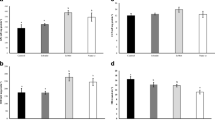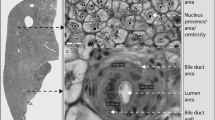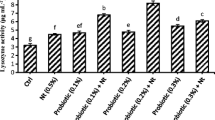Abstract
The aim of this study was to assess the effects of different dietary selenium sources, selenium nanoparticle (nSe), and selenomethionine (SeMet) as feed additives on growth performance, hepatic enzymes’ activity, biochemical, mucosal immune parameters, liver histology, and appetite-related gene transcript in goldfish (Carassius auratus). At first, goldfish juveniles (n=480; mean 4.54 g) were fed dietary selenium nanoparticle at 0, 0.3, 0.6, and 0.9 mg nSe/kg diet and SeMet at 0, 0.3, 0.6, and 0.9 mg Se/kg for 9 weeks. Growth performance was evaluated using standard procedures. Blood, skin mucus, and tissue samples (liver and intestine) were collected for biochemical, mucosal immune response, histology, and ghrelin and insulin-like growth factor-I (IGF-I) gene expression. The results showed that fish fed diets fortified with 0.6 mg nSe/kg and 0.6 mg Se/kg had a significant higher weight gain, specific growth rates (SGR), and lower feed conversion ratios (FCR) than fish fed basal diets (p<0.05). Furthermore, dietary nSe and SeMet enhanced blood biochemical profiles especially alkaline phosphatase (ALP) (p < 0.05) and mucosal immunity than the control group in goldfish. Moreover, the liver histological investigation showed that fish fed 0.9 mg of SeMet and nSe kg−1 diets had higher liver lesion scores such as karyolysis, lipidosis, and hyperemia while fish fed 0, 0.3, and 0.6 mg of SeMet and nSe kg−1 diets had small liver changes at 9 weeks. The study further established that inclusion of nSe and SeMet in the diet of goldfish greatly promoted ghrelin and IGF-1genes expressions (p <0.05). Overall, dietary nSe performs better than SeMet and basal diets. The results evoked that nSe and SeMet stimulate the growth, biochemical, and mucosal immunity in goldfish at 0.6 mg/kg.



Similar content being viewed by others
Data availability
The data that support the findings of this study are available from the corresponding author, upon reasonable request.
References
Adeshina I, Jenyo-Oni A, Emikpe BO, Ajani EK, Abdel-Tawwab M (2019) Stimulatory effect of dietary clove, Eugenia caryophyllata, bud extract on growth performance, nutrient utilization, antioxidant capacity, and tolerance of African catfish, Clarias gariepinus (B.), to Aeromonas hydrophila infection. J World Aquacult Soc 50(2):390–405. https://doi.org/10.1111/jwas.12565
Adeshina I, Abdel-Tawwab M, Tijjani ZA, Tiamiyu LO, Jahanbakhshi A (2021) Dietary Tridax procumbens leaves extract stimulated growth, antioxidants, immunity, and resistance of Nile tilapia, Oreochromis niloticus, to monogenean parasitic infection. Aquaculture 532:1–7. https://doi.org/10.1016/j.aquaculture.2020.736047
Ahmadi PY, Farahmand H, Miandare HK, Mirvaghefi A, Hoseinifar SH (2014) The effects of dietary Immunogen® on innate immune response, immune related genes expression and disease resistance of rainbow trout (Oncorhynchus mykiss). Fish Shellfish Immunol 37(2):209–214. https://doi.org/10.1016/j.fsi.2014.02.006
Akbary P, Jahanbakhshi A (2018) Growth yield, survival, carcass quality, haematological, biochemical parameters and innate immune responses in the grey mullet (Mugil cephalus Linneaus, 1758) fingerling induced by Immunogen® prebiotic. J Appl Anim Res 46(1):10–16. https://doi.org/10.1080/09712119.2016.1251927
Akbary P, Jahanbakhshi A (2019) Nano and macro iron oxide (Fe2O3) as feed additives: effects on growth, biochemical, activity of hepatic enzymes, liver histopathology and appetite-related gene transcript in goldfish (Carassius auratus). Aquaculture 510:191–197. https://doi.org/10.1016/j.aquaculture.2019.05.052
Akbary P, Pirbeigi A, Jahanbakhshi A (2016) Analysis of primary and secondary stress responses in bighead carp (Hypophthalmichthys nobilis) by anesthetization with 2-phenoxyethanol. J Environ Sci Technol 13(4):1009–1016
Akbary P, Yarahmadi SS, Jahanbakhshi A (2018) Hematological, hepatic enzymes’ activity and oxidative stress responses of gray mullet (Mugil cephalus) after sub-acute exposure to copper oxide. Environ Scie Pollut R 25(2):1800–1808
Akib NAM, Tam BM, Phumee P, Abidin MZ, Tamadoni S, Mather PB, Nor SAM (2015) High connectivity in Rastrelliger kanagurta: influence of historical signatures and migratory behaviour inferred from mtDNA cytochrome b. PLoS One 10:1–18. https://doi.org/10.1371/journal.pone.0119749
Akter N, Alam MJ, Jewel MAS, Ayenuddin M, Haque SK, Akter S (2018) Evaluation of dietary metallic iron nanoparticles as feed additive for growth and physiology of Bagridae catfish Clarias batrachus (Linnaeus, 1758). Int J Fish Aquat Stud 6(3):371–377
Ashouri S, Keyvanshokooh S, Salati AP, Johari SA, Pasha-Zanoosi H (2015) Effects of different levels of dietary selenium nanoparticles on growth performance, muscle composition, blood biochemical profiles and antioxidant status of common carp (Cyprinus carpio). Aquaculture 446:25–29. https://doi.org/10.1016/j.aquaculture.2015.04.021
Azarin H, Imanpour MR, Karamad A, Jebeleh AR, Pourmozaffar S (2020) In vitro oocyte maturation and blood-circulating steroid hormones in Sterlet (Acipenser ruthenus) and Siberian sturgeon (Acipenser baeri). Aquac Res 51:1–7. https://doi.org/10.1111/are.14683
Bitiren M, Karakılçık AZ, Zerin M, Aksoy N, Musa D (2004) Effects of selenium on histopathological and enzymatic changes in experimental liver injury of rats. Exp Toxicol Pathol 56(1-2):59–64
Cotter PA, Craig SR, McLean E (2008) Hyperaccumulation of selenium in hybrid striped bass: a functional food for aquaculture? Aquac Nutr 14(3):215–222
Dawood MA, Koshio S, Zaineldin AI, Van Doan H, Moustafa EM, Abdel-Daim MM, Hassaan MS (2019) Dietary supplementation of selenium nanoparticles modulated systemic and mucosal immune status and stress resistance of red sea bream (Pagrus major). Fish Physiol Biochem 45(1):219–230
Dong ZJ (2000) Selenium and fish nutrition: a review. J Shanghai Fish Univ 9:247–253
Dutta HM, Adhikari S, Singh NK, Roy PK, Munshi JS (1993) Histopathological changes induced by malathion in the liver of a freshwater catfish, Heteropneustes fossilis (Bloch). Bull Environ Contam Toxicol 51(6):895–900
Esteban MA, Cuesta A, Ortuno J, Meseguer J (2001) Immunomodulatory effects of dietary intake of chitin on gilthead seabream (Sparus aurata L.) innate immune system. Fish Shellfish Immunol 11(4):303–315
Fjoelstad, M., Heyeraas, A. L. (1985). Muscular and myocardial degeneration in cultured Atlantic salmon, Salmo salar L., suffering from ‘Hitra disease. J. Fish Dis., 8(4), 367–372.
Gatlin DM, Wilson RP (1984) Dietary selenium requirement of fingerling channel catfish. J Nutr 114:627–633. https://doi.org/10.1093/jn/114.3.627
Gozari M, Zaheri A, Jahromi ST, Gozari M, Karimzadeh R (2019) Screening and characterization of marine actinomycetes from the northern Oman Sea sediments for cytotoxic and antimicrobial activity. Int Microbiol 22:521–530. https://doi.org/10.1007/s10123-019-00083-3
Gurung S, Bohara K, Adhikari R, Bista A, Singh S (2018) Growth performance and feeding efficiency of goldfish (Carassius auratus) and red cap oranda fish (Carassius auratus auratus) by using different locally prepared feed mixed with different plant extracts at Paklihawa. Nepal J Inst Agricult Anim Sci 35(1):277–284
Haham M, Ish-Shalom S, Nodelman M, Duek I, Segal E, Kustanovich M, Livney YD (2012) Stability and bioavailability of vitamin D nanoencapsulated in casein micelles. Food Funct 3(7):737–744
Han D, Xie S, Liu M, Xiao X, Liu H, Zhu X, Yang Y (2011) The effects of dietary selenium on growth performances, oxidative stress and tissue selenium concentration of gibel carp (Carassius auratus gibelio). Aquac Nutr 17(3):e741–e749
Hao X, Ling Q, Hong F (2014) Effects of dietary selenium on the pathological changes and oxidative stress in loach (Paramisgurnus dabryanus). Fish Physiol Biochem 40(5):1313–1323
Haschek WM, Walling MA, Rousseaux C (2010) Fundamental of toxicologic pathology. Academic Press, New York, p 686
Hashizume T, Horiuchi M, Tate N, Nonaka S, Mikami U, Kojima M (2003) Effects of ghrelin on growth hormone secretion from cultured adenohypophysial cells in pigs. Domest Anim Endocrinol 24(3):209–218
Hoseinifar SH, Jahazi MA, Mohseni R, Raeisi M, Bayani M, Mazandarani M, Yousefi M, Van Doan H, Mozanzadeh MT (2020) Effects of dietary fern (Adiantum capillus-veneris) leaves powder on serum and mucus antioxidant defence, immunological responses, antimicrobial activity and growth performance of common carp (Cyprinus carpio) juveniles. Fish & Shellfish Immunology 106:959–966
Huang Q, Yu H, Ru Q (2010) Bioavailability and delivery of nutraceuticals using nanotechnology. J Food Sci 75(1):50–57
Hunt AO, Berkoz M, Ozkan F, Yalin S, Ercen Z, Erdogan E, Gunduz SG (2011) Effects of organic selenium on growth, muscle composition, and antioxidant system in rainbow trout. Isr J Aquac 63(562):10
Izadpanah Qeshmi F, Javadpour S, Malekzadeh K et al (2014) Persian Gulf is a bioresource of potent L-asparaginase producing bacteria: isolation & molecular differentiating. Int J Environ Res 8:813–818
Jahanbakhshi A, Hedayati A (2013) The effect of water-soluble fraction of crude oil on serum biochemical changes in the great sturgeon Huso huso. Comp Clin Pathol 22(6):1099–1102
Jahanbakhshi A, Baghfalaki M, Imanpour MR, Nodeh AJ, Shaluei F (2013) Effects of different concentrations of 2-phenoxyethanol on primary and secondary stress responses in Persian sturgeon, Acipenser persicus. J Appl Ichthyol 29(3):499–502
Khalil HS, Mansour AT, Goda AMA, Omar EA (2019) Effect of selenium yeast supplementation on growth performance, feed utilization, lipid profile, liver and intestine histological changes, and economic benefit in meagre, Argyrosomus regius, fingerlings. Aquaculture 501:135–143. https://doi.org/10.1016/j.aquaculture.2018.11.018
Khan KU, Zuberi A, Nazir S et al (2016) Effects of dietary selenium nanoparticles on physiological and biochemical aspects of juvenile Tor putitora. Turkish J Zool 40:704–712. https://doi.org/10.3906/zoo-1510-5
Klok MD, Jakobsdottir S, Drent ML (2007) The role of leptin and ghrelin in the regulation of food intake and body weight in humans: a review. Obes Rev 8(1):21–34
Lin YH, Shiau SY (2005) Dietary selenium requirements of juvenile grouper, Epinephelus malabaricus. Aquaculture 250(1–2):356–363
Lin S, Lin X, Yang Y, Li F, Luo L (2013) Comparison of chelated zinc and zinc sulfate as zinc sources for growth and immune response of shrimp (Litopenaeus vannamei). Aquaculture 406–407:79–84. https://doi.org/10.1016/j.aquaculture.2013.04.026
Livak, K. J., Schmittgen, T. D. (2001). Analysis of relative gene expression data using real-time quantitative PCR and the 2− ΔΔCT method. methods, 25(4), 402-408.
Lowry OH, Rosebrough NJ, Farr AL, Randall RJ (1951) Protein measurement with the Folin phenol reagent. J boil chem 193:265–275
Mechlaoui M, Dominguez D, Robaina L, Geraert PA, Kaushik S, Saleh R, Briens M, Montero D, Izquierdo M (2019) Effects of different dietary selenium sources on growth performance, liver and muscle composition, antioxidant status, stress response and expression of related genes in gilthead seabream (Sparus aurata). Aquaculture 507:251–259. https://doi.org/10.1016/j.aquaculture.2019.04.037
Mimeault C, Woodhouse AJ, Miao X et al (2005) The human lipid regulator, gemfibrozil bioconcentrates and reduces testosterone in the goldfish, Carassius auratus. Aquat Toxicol 73:44–54. https://doi.org/10.1016/j.aquatox.2005.01.009
Nakagawa H, Sato M, Gatlin DM (2007) Dietary supplements for the health and quality of cultured fish. CAB International CABI.
Nazari K, Shamsaie M, Eila N et al (2017) The effects of different dietary levels of organic and inorganic selenium on some growth performance and proximate composition of juvenile rainbow trout (Oncorhynchus mykiss). Iran J Fish Sci 16:238–251
Pacitti D, Lawan MM, Sweetman J, Martin SAM, Feldmann J, Secombes CJ (2015) Selenium supplementation in fish: a combined chemical and biomolecular study to understand Sel-Plex assimilation and impact on selenoproteome expression in rainbow trout (Oncorhynchus mykiss). PLoS One 10:1–17. https://doi.org/10.1371/journal.pone.0127041
Pirian K, Piri K, Sohrabipour J, Jahromi ST, Blomster J (2016a) Nutritional and phytochemical evaluation of the common green algae, Ulva spp. (Ulvophyceae), from the Persian Gulf. Fundam Appl Limnol 188:315–327. https://doi.org/10.1127/fal/2016/0947
Pirian K, Piri K, Sohrabipour J, Tamadoni Jahromi S, Blomster J (2016b) Molecular and morphological characterisation of Ulva chaugulii, U. paschima and U. ohnoi (Ulvophyceae) from the Persian Gulf, Iran. Bot Mar 59:147–158. https://doi.org/10.1515/bot-2016-0009
Poppe TT, HAstein T, Frsslie A, Koppang N, Norheim G (1986) Nutritional aspects of Haemorrhagic Syndrome (‘Hitra Disease’) in farmed Atlantic salmon Salmo. Dis Aquat Org 1:155–162
Pourmozaffar S, Hajimoradloo A, Kolangi Miandare H (2017) Dietary effect of apple cider vinegar and propionic acid on immune related transcriptional responses and growth performance in white shrimp, Litopenaeus vannamei. Fish Shellfish Immunol 60:65–71. https://doi.org/10.1016/j.fsi.2016.11.030
Pourmozaffar S, Tamadoni Jahromi S, Rameshi H, Gozari M (2019) Evaluation of some haemolymph biochemical properties and F-cell prevalence in hepatopancreas of white leg shrimp (Litopenaeus vanammei) after fed diets containing apple cider vinegar and propionic acid. Aquac Res 50:3435–3443. https://doi.org/10.1111/are.14303
Prabhu PAJ, Schrama JW, Kaushik SJ (2016) Mineral requirements of fish: a systematic review. Rev Aquac 8:172–219. https://doi.org/10.1111/raq.12090
Ribeiro CO, Neto FF, Mela M, Silva PH, Randi MAF, Rabitto IS, Pelletier E (2006) Hematological findings in neotropical fish Hoplias malabaricus exposed to subchronic and dietary doses of methylmercury, inorganic lead, and tributyltin chloride. Environ Res 101(1):74–80
Safari R, Hoseinifar SH, Nejadmoghadam S, Jafar A (2016) Transciptomic study of mucosal immune, antioxidant and growth related genes and non-specific immune response of common carp (Cyprinus carpio) fed dietary Ferula (Ferula assafoetida). Fish Shellfish Immunol 55:242–248. https://doi.org/10.1016/j.fsi.2016.05.038
Safari R, Hoseinifar SH, Nejadmoghadam S, Khalili M (2017) Apple cider vinegar boosted immunomodulatory and health promoting effects of Lactobacillus casei in common carp (Cyprinus carpio). Fish Shellfish Immunol 67:441–448. https://doi.org/10.1016/j.fsi.2017.06.017
Semo E, Kesselman E, Danino D, Livney YD (2007) Casein micelle as a natural nano-capsular vehicle for nutraceuticals. Food Hydrocoll 21(5-6):936–942
Shaluei F, Hedayati A, Jahanbakhshi A, Kolangi H, Fotovat M (2013) Effect of subacute exposure to silver nanoparticle on some hematological and plasma biochemical indices in silver carp (Hypophthalmichthys molitrix). Hum Exp Toxicol 32(12):1270–1277
Shpigelman A, Cohen Y, Livney YD (2012) Thermally-induced β-lactoglobulin–EGCG nanovehicles: loading, stability, sensory and digestive-release study. Food Hydrocoll 29(1):57–67
Silva HD, Cerqueira MÂ, Vicente AA (2012) Nanoemulsions for food applications: development and characterization. Food Bioprocess Technol 5(3):854–867
Tamadoni Jahromi S, Pourmozaffar S, Jahanbakhshi A et al (2020a) Effect of different levels of dietary Sargassum cristaefolium on growth performance, hematological parameters, histological structure of hepatopancreas and intestinal microbiota of Litopenaeus vannamei. Aquaculture 533:1–17. https://doi.org/10.1016/j.aquaculture.2020.736130
Tamadoni Jahromi S, Pourmozaffar S, Rameshi H et al (2020b) Evaluation of hemolymph biochemical properties, clearance rate, bacterial microbiota and expression of HSP genes of gulf pearl oyster Pinctada radiata in response to salinity changes. Fish Sci 86:1–11. https://doi.org/10.1007/s12562-020-01459-5
Tamadoni Jahromi S, Sofman Othman A, Rosazlina R et al (2021) Population genetics of Penaeus semisulcatus from the Persian Gulf and Oman Sea using newly developed DNA microsatellite markers. Iran J Fish Sci 1-28
Tashjian DH, Teh SJ, Sogomonyan A, Hung SS (2006) Bioaccumulation and chronic toxicity of dietary l-selenomethionine in juvenile white sturgeon (Acipenser transmontanus). Aquat Toxicol 79(4):401–409
Teh SJ, Deng X, Deng DF, Teh FC, Hung SS, Fan TWM, Higashi RM (2004) Chronic effects of dietary selenium on juvenile Sacramento splittail (Pogonichthys macrolepidotus). Environ Sci Technol 38(22):6085–6093
Tinggi U (1999) Determination of selenium in meat products by hydride generation atomic absorption spectrophotometry. J AOAC Int 82:364–367
Vangen B, Hemre GI (2003) Dietary carbohydrate, iron and zinc interactions in Atlantic salmon (Salmo salar). Aquaculture 219(1-4):597–611
Vidal D, Bay SM, Schlenk D (2005) Effects of dietary selenomethionine on larval rainbow trout (Oncorhynchus mykiss). Arch Environ Contam Toxicol 49(1):71–75
Watanabe T, Kiron V, Satoh S (1997) Trace minerals in fish nutrition. Aquaculture 151(1-4):185–207
Zhou X, Wang Y, Gu Q, Li W (2009) Effects of different dietary selenium sources (selenium nanoparticle and selenomethionine) on growth performance, muscle composition and glutathione peroxidase enzyme activity of Crucian carp (Carassius auratus gibelio). Aquaculture 291:78–81. https://doi.org/10.1016/j.aquaculture.2009.03.007
Zimet P, Livney YD (2009) Beta-lactoglobulin and its nanocomplexes with pectin as vehicles for ω-3 polyunsaturated fatty acids. Food Hydrocoll 23(4):1120–1126. https://doi.org/10.1016/j.foodhyd.2008.10.008
Acknowledgements
We are grateful to the Taleghani Hospital of Gorgan for providing technical facilities.
Author information
Authors and Affiliations
Contributions
All authors have participated in (a) conception and design, or analysis and interpretation of the data; (b) drafting the article or revising it critically for important intellectual content; and (c) approval of the final version.
Corresponding authors
Ethics declarations
Ethics approval
Not applicable as fish do not require ethical permits. No permits were required for the fish sampling.
Conflict of interest
The authors declare no competing interests.
Additional information
Publisher’s note
Springer Nature remains neutral with regard to jurisdictional claims in published maps and institutional affiliations.
Rights and permissions
About this article
Cite this article
Jahanbakhshi, A., Pourmozaffar, S., Adeshina, I. et al. Selenium nanoparticle and selenomethionine as feed additives: effects on growth performance, hepatic enzymes’ activity, mucosal immune parameters, liver histology, and appetite-related gene transcript in goldfish (Carassius auratus). Fish Physiol Biochem 47, 639–652 (2021). https://doi.org/10.1007/s10695-021-00937-6
Received:
Accepted:
Published:
Issue Date:
DOI: https://doi.org/10.1007/s10695-021-00937-6




